Impact of US-China Trade Deal on Australia: Economic Analysis Report
VerifiedAdded on 2023/01/10
|10
|2437
|67
Report
AI Summary
This report provides an in-depth economic analysis of the US-China trade deal and its impact on Australia. It begins with an event description of the deal, which involves China's commitment to purchase US goods, potentially at the expense of Australian farmers. The report then delves into a microeconomic analysis, examining demand and supply, market structure, and externalities, highlighting the effects of trade tensions and tariff rates on Australia's economy. The macroeconomic analysis covers GDP, unemployment, fiscal policy, and monetary policy, discussing the potential impacts of the trade deal on these factors. The report concludes by emphasizing Australia's welcoming stance towards the deal, despite potential costs, due to its positive impact on global confidence and economic growth, especially considering the backdrop of the COVID-19 pandemic. The analysis incorporates relevant economic concepts and data to provide a comprehensive understanding of the trade deal's implications.
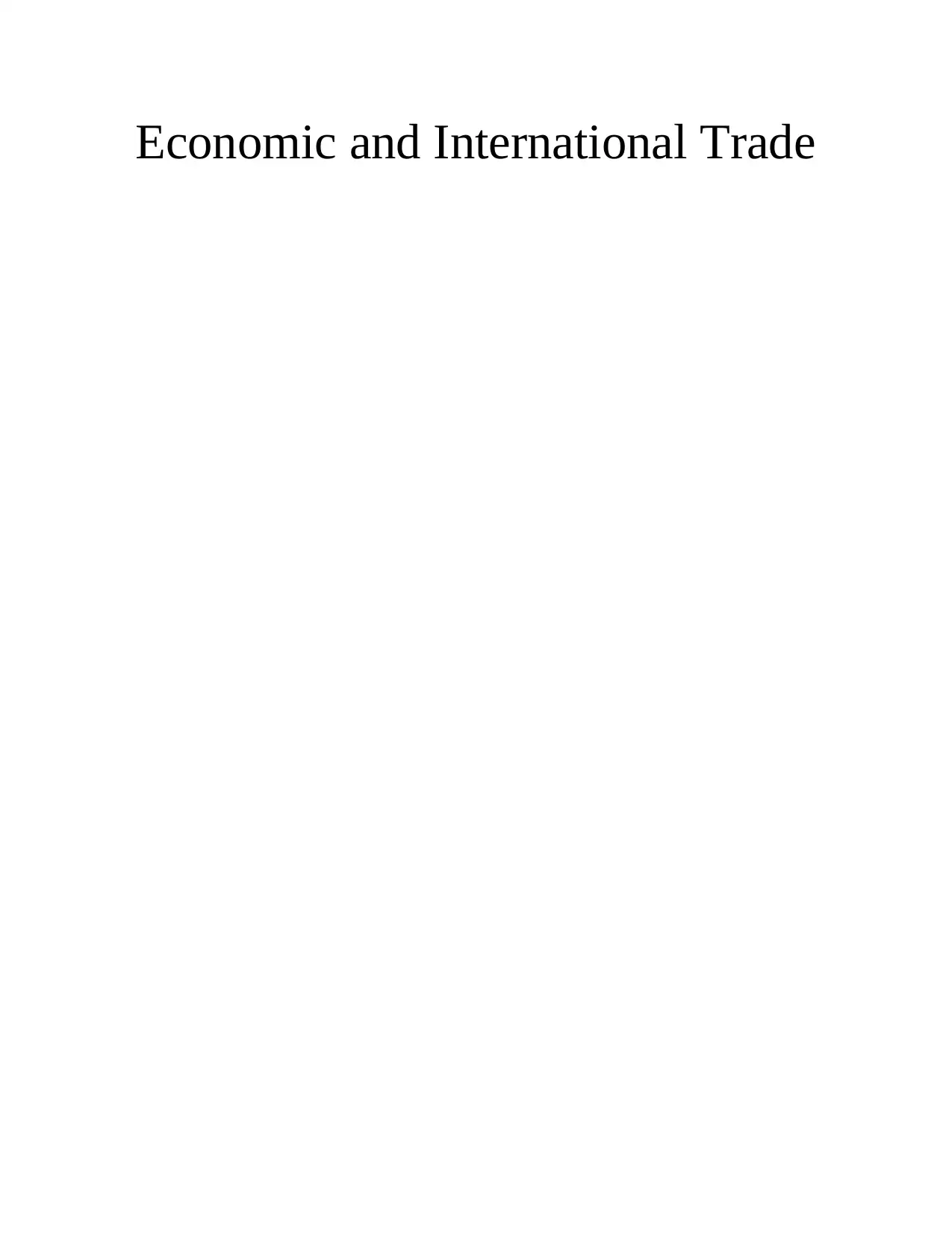
Economic and International Trade
Paraphrase This Document
Need a fresh take? Get an instant paraphrase of this document with our AI Paraphraser
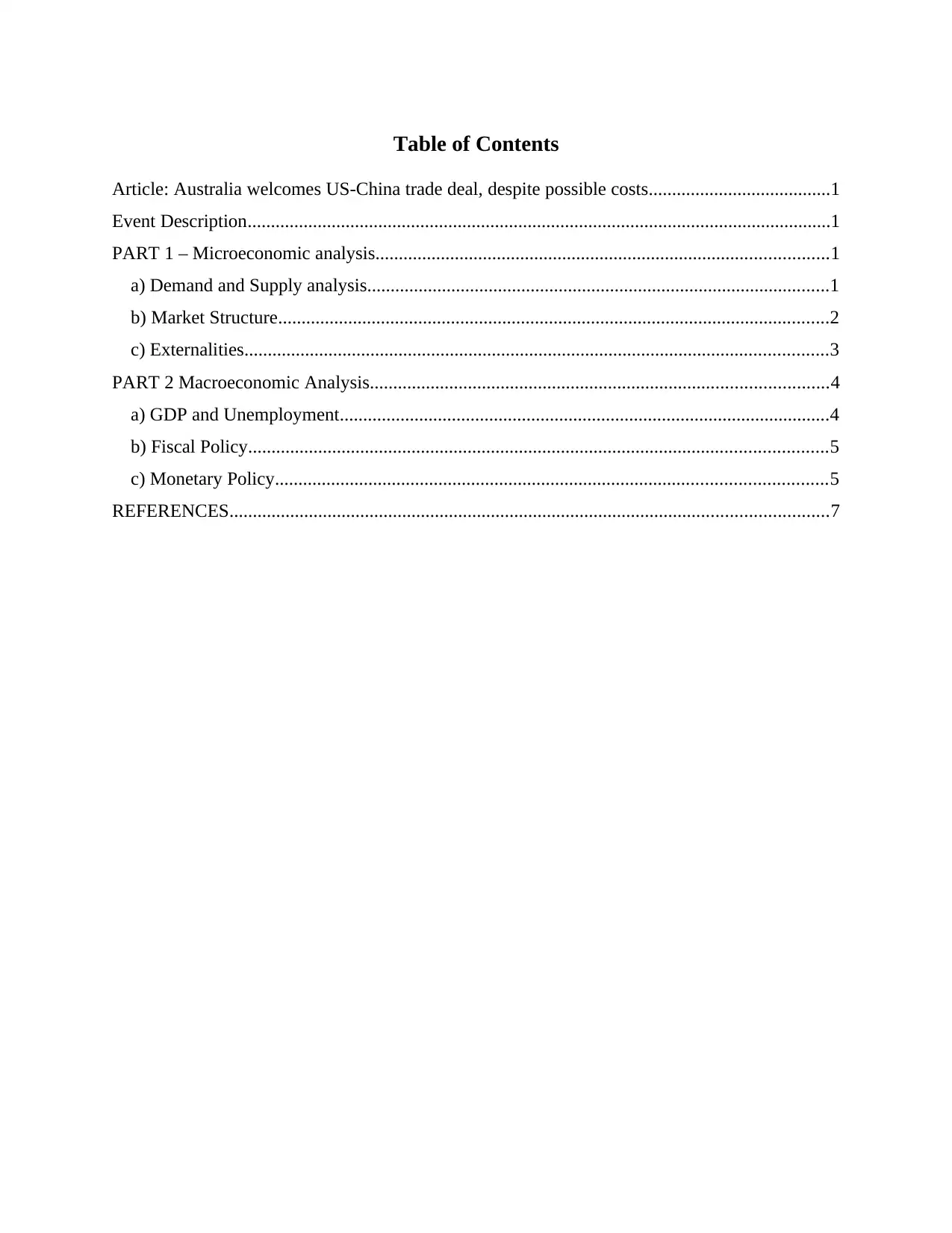
Table of Contents
Article: Australia welcomes US-China trade deal, despite possible costs.......................................1
Event Description.............................................................................................................................1
PART 1 – Microeconomic analysis.................................................................................................1
a) Demand and Supply analysis...................................................................................................1
b) Market Structure......................................................................................................................2
c) Externalities.............................................................................................................................3
PART 2 Macroeconomic Analysis..................................................................................................4
a) GDP and Unemployment.........................................................................................................4
b) Fiscal Policy............................................................................................................................5
c) Monetary Policy......................................................................................................................5
REFERENCES................................................................................................................................7
Article: Australia welcomes US-China trade deal, despite possible costs.......................................1
Event Description.............................................................................................................................1
PART 1 – Microeconomic analysis.................................................................................................1
a) Demand and Supply analysis...................................................................................................1
b) Market Structure......................................................................................................................2
c) Externalities.............................................................................................................................3
PART 2 Macroeconomic Analysis..................................................................................................4
a) GDP and Unemployment.........................................................................................................4
b) Fiscal Policy............................................................................................................................5
c) Monetary Policy......................................................................................................................5
REFERENCES................................................................................................................................7

⊘ This is a preview!⊘
Do you want full access?
Subscribe today to unlock all pages.

Trusted by 1+ million students worldwide
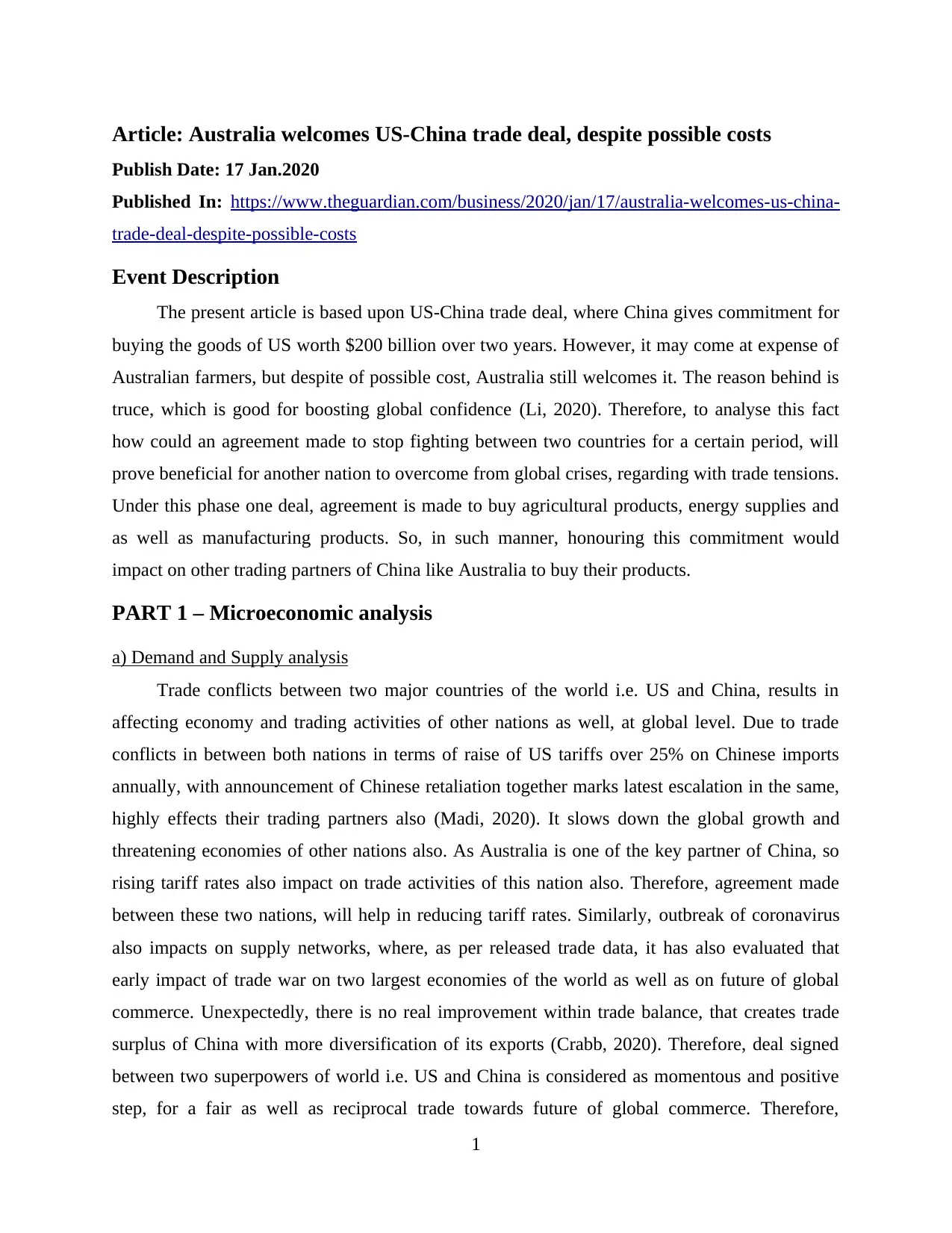
Article: Australia welcomes US-China trade deal, despite possible costs
Publish Date: 17 Jan.2020
Published In: https://www.theguardian.com/business/2020/jan/17/australia-welcomes-us-china-
trade-deal-despite-possible-costs
Event Description
The present article is based upon US-China trade deal, where China gives commitment for
buying the goods of US worth $200 billion over two years. However, it may come at expense of
Australian farmers, but despite of possible cost, Australia still welcomes it. The reason behind is
truce, which is good for boosting global confidence (Li, 2020). Therefore, to analyse this fact
how could an agreement made to stop fighting between two countries for a certain period, will
prove beneficial for another nation to overcome from global crises, regarding with trade tensions.
Under this phase one deal, agreement is made to buy agricultural products, energy supplies and
as well as manufacturing products. So, in such manner, honouring this commitment would
impact on other trading partners of China like Australia to buy their products.
PART 1 – Microeconomic analysis
a) Demand and Supply analysis
Trade conflicts between two major countries of the world i.e. US and China, results in
affecting economy and trading activities of other nations as well, at global level. Due to trade
conflicts in between both nations in terms of raise of US tariffs over 25% on Chinese imports
annually, with announcement of Chinese retaliation together marks latest escalation in the same,
highly effects their trading partners also (Madi, 2020). It slows down the global growth and
threatening economies of other nations also. As Australia is one of the key partner of China, so
rising tariff rates also impact on trade activities of this nation also. Therefore, agreement made
between these two nations, will help in reducing tariff rates. Similarly, outbreak of coronavirus
also impacts on supply networks, where, as per released trade data, it has also evaluated that
early impact of trade war on two largest economies of the world as well as on future of global
commerce. Unexpectedly, there is no real improvement within trade balance, that creates trade
surplus of China with more diversification of its exports (Crabb, 2020). Therefore, deal signed
between two superpowers of world i.e. US and China is considered as momentous and positive
step, for a fair as well as reciprocal trade towards future of global commerce. Therefore,
1
Publish Date: 17 Jan.2020
Published In: https://www.theguardian.com/business/2020/jan/17/australia-welcomes-us-china-
trade-deal-despite-possible-costs
Event Description
The present article is based upon US-China trade deal, where China gives commitment for
buying the goods of US worth $200 billion over two years. However, it may come at expense of
Australian farmers, but despite of possible cost, Australia still welcomes it. The reason behind is
truce, which is good for boosting global confidence (Li, 2020). Therefore, to analyse this fact
how could an agreement made to stop fighting between two countries for a certain period, will
prove beneficial for another nation to overcome from global crises, regarding with trade tensions.
Under this phase one deal, agreement is made to buy agricultural products, energy supplies and
as well as manufacturing products. So, in such manner, honouring this commitment would
impact on other trading partners of China like Australia to buy their products.
PART 1 – Microeconomic analysis
a) Demand and Supply analysis
Trade conflicts between two major countries of the world i.e. US and China, results in
affecting economy and trading activities of other nations as well, at global level. Due to trade
conflicts in between both nations in terms of raise of US tariffs over 25% on Chinese imports
annually, with announcement of Chinese retaliation together marks latest escalation in the same,
highly effects their trading partners also (Madi, 2020). It slows down the global growth and
threatening economies of other nations also. As Australia is one of the key partner of China, so
rising tariff rates also impact on trade activities of this nation also. Therefore, agreement made
between these two nations, will help in reducing tariff rates. Similarly, outbreak of coronavirus
also impacts on supply networks, where, as per released trade data, it has also evaluated that
early impact of trade war on two largest economies of the world as well as on future of global
commerce. Unexpectedly, there is no real improvement within trade balance, that creates trade
surplus of China with more diversification of its exports (Crabb, 2020). Therefore, deal signed
between two superpowers of world i.e. US and China is considered as momentous and positive
step, for a fair as well as reciprocal trade towards future of global commerce. Therefore,
1
Paraphrase This Document
Need a fresh take? Get an instant paraphrase of this document with our AI Paraphraser
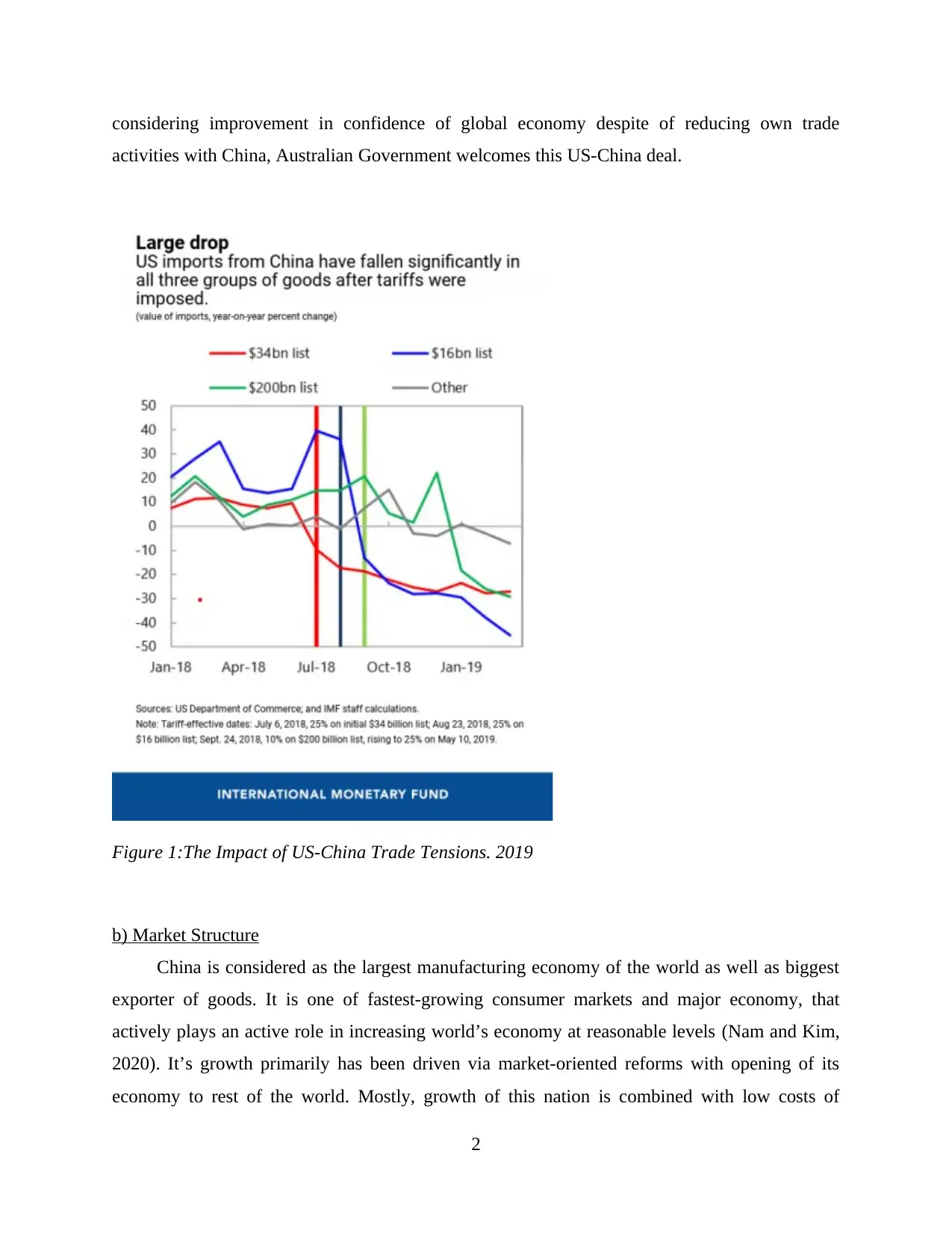
considering improvement in confidence of global economy despite of reducing own trade
activities with China, Australian Government welcomes this US-China deal.
Figure 1:The Impact of US-China Trade Tensions. 2019
b) Market Structure
China is considered as the largest manufacturing economy of the world as well as biggest
exporter of goods. It is one of fastest-growing consumer markets and major economy, that
actively plays an active role in increasing world’s economy at reasonable levels (Nam and Kim,
2020). It’s growth primarily has been driven via market-oriented reforms with opening of its
economy to rest of the world. Mostly, growth of this nation is combined with low costs of
2
activities with China, Australian Government welcomes this US-China deal.
Figure 1:The Impact of US-China Trade Tensions. 2019
b) Market Structure
China is considered as the largest manufacturing economy of the world as well as biggest
exporter of goods. It is one of fastest-growing consumer markets and major economy, that
actively plays an active role in increasing world’s economy at reasonable levels (Nam and Kim,
2020). It’s growth primarily has been driven via market-oriented reforms with opening of its
economy to rest of the world. Mostly, growth of this nation is combined with low costs of
2
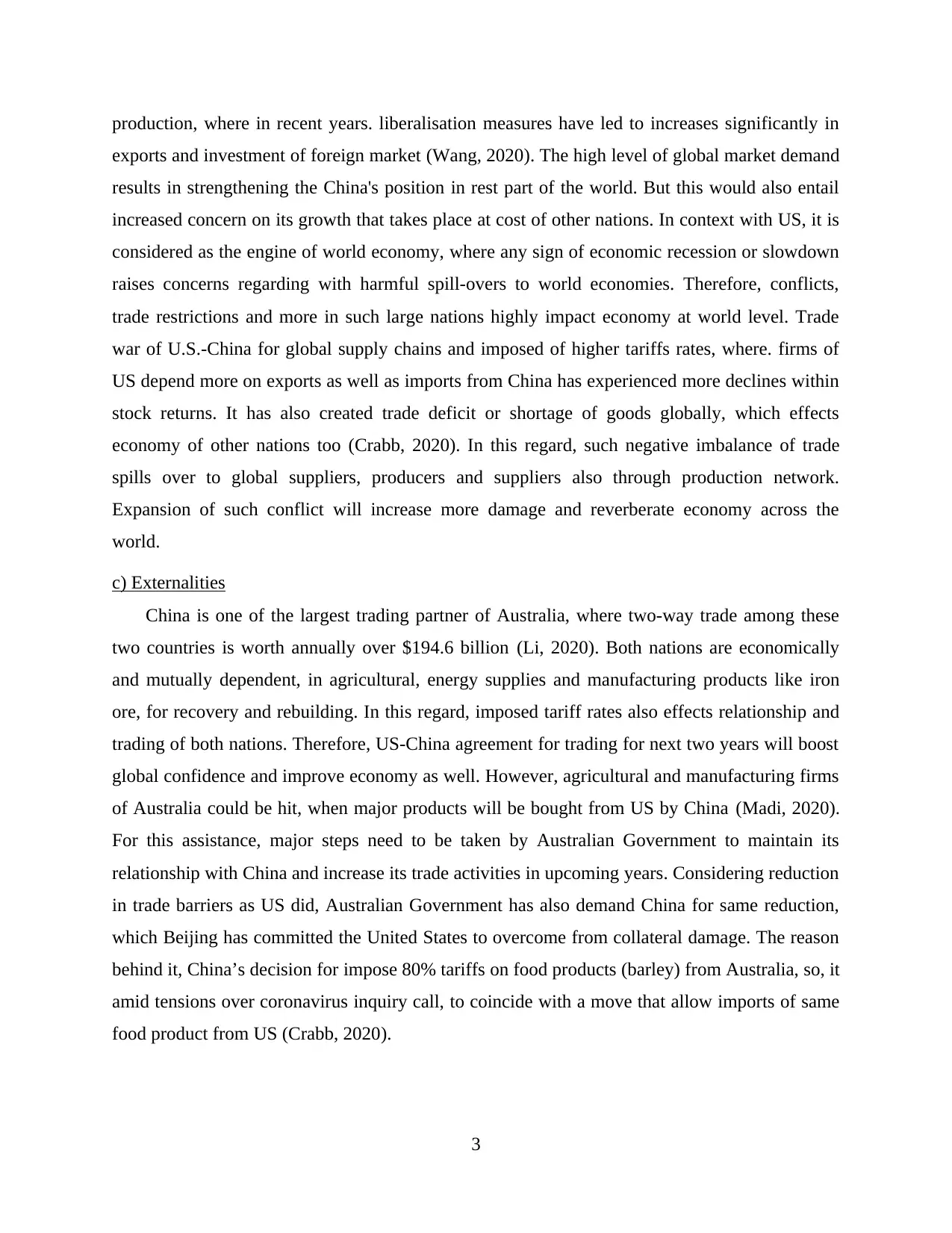
production, where in recent years. liberalisation measures have led to increases significantly in
exports and investment of foreign market (Wang, 2020). The high level of global market demand
results in strengthening the China's position in rest part of the world. But this would also entail
increased concern on its growth that takes place at cost of other nations. In context with US, it is
considered as the engine of world economy, where any sign of economic recession or slowdown
raises concerns regarding with harmful spill-overs to world economies. Therefore, conflicts,
trade restrictions and more in such large nations highly impact economy at world level. Trade
war of U.S.-China for global supply chains and imposed of higher tariffs rates, where. firms of
US depend more on exports as well as imports from China has experienced more declines within
stock returns. It has also created trade deficit or shortage of goods globally, which effects
economy of other nations too (Crabb, 2020). In this regard, such negative imbalance of trade
spills over to global suppliers, producers and suppliers also through production network.
Expansion of such conflict will increase more damage and reverberate economy across the
world.
c) Externalities
China is one of the largest trading partner of Australia, where two-way trade among these
two countries is worth annually over $194.6 billion (Li, 2020). Both nations are economically
and mutually dependent, in agricultural, energy supplies and manufacturing products like iron
ore, for recovery and rebuilding. In this regard, imposed tariff rates also effects relationship and
trading of both nations. Therefore, US-China agreement for trading for next two years will boost
global confidence and improve economy as well. However, agricultural and manufacturing firms
of Australia could be hit, when major products will be bought from US by China (Madi, 2020).
For this assistance, major steps need to be taken by Australian Government to maintain its
relationship with China and increase its trade activities in upcoming years. Considering reduction
in trade barriers as US did, Australian Government has also demand China for same reduction,
which Beijing has committed the United States to overcome from collateral damage. The reason
behind it, China’s decision for impose 80% tariffs on food products (barley) from Australia, so, it
amid tensions over coronavirus inquiry call, to coincide with a move that allow imports of same
food product from US (Crabb, 2020).
3
exports and investment of foreign market (Wang, 2020). The high level of global market demand
results in strengthening the China's position in rest part of the world. But this would also entail
increased concern on its growth that takes place at cost of other nations. In context with US, it is
considered as the engine of world economy, where any sign of economic recession or slowdown
raises concerns regarding with harmful spill-overs to world economies. Therefore, conflicts,
trade restrictions and more in such large nations highly impact economy at world level. Trade
war of U.S.-China for global supply chains and imposed of higher tariffs rates, where. firms of
US depend more on exports as well as imports from China has experienced more declines within
stock returns. It has also created trade deficit or shortage of goods globally, which effects
economy of other nations too (Crabb, 2020). In this regard, such negative imbalance of trade
spills over to global suppliers, producers and suppliers also through production network.
Expansion of such conflict will increase more damage and reverberate economy across the
world.
c) Externalities
China is one of the largest trading partner of Australia, where two-way trade among these
two countries is worth annually over $194.6 billion (Li, 2020). Both nations are economically
and mutually dependent, in agricultural, energy supplies and manufacturing products like iron
ore, for recovery and rebuilding. In this regard, imposed tariff rates also effects relationship and
trading of both nations. Therefore, US-China agreement for trading for next two years will boost
global confidence and improve economy as well. However, agricultural and manufacturing firms
of Australia could be hit, when major products will be bought from US by China (Madi, 2020).
For this assistance, major steps need to be taken by Australian Government to maintain its
relationship with China and increase its trade activities in upcoming years. Considering reduction
in trade barriers as US did, Australian Government has also demand China for same reduction,
which Beijing has committed the United States to overcome from collateral damage. The reason
behind it, China’s decision for impose 80% tariffs on food products (barley) from Australia, so, it
amid tensions over coronavirus inquiry call, to coincide with a move that allow imports of same
food product from US (Crabb, 2020).
3
⊘ This is a preview!⊘
Do you want full access?
Subscribe today to unlock all pages.

Trusted by 1+ million students worldwide
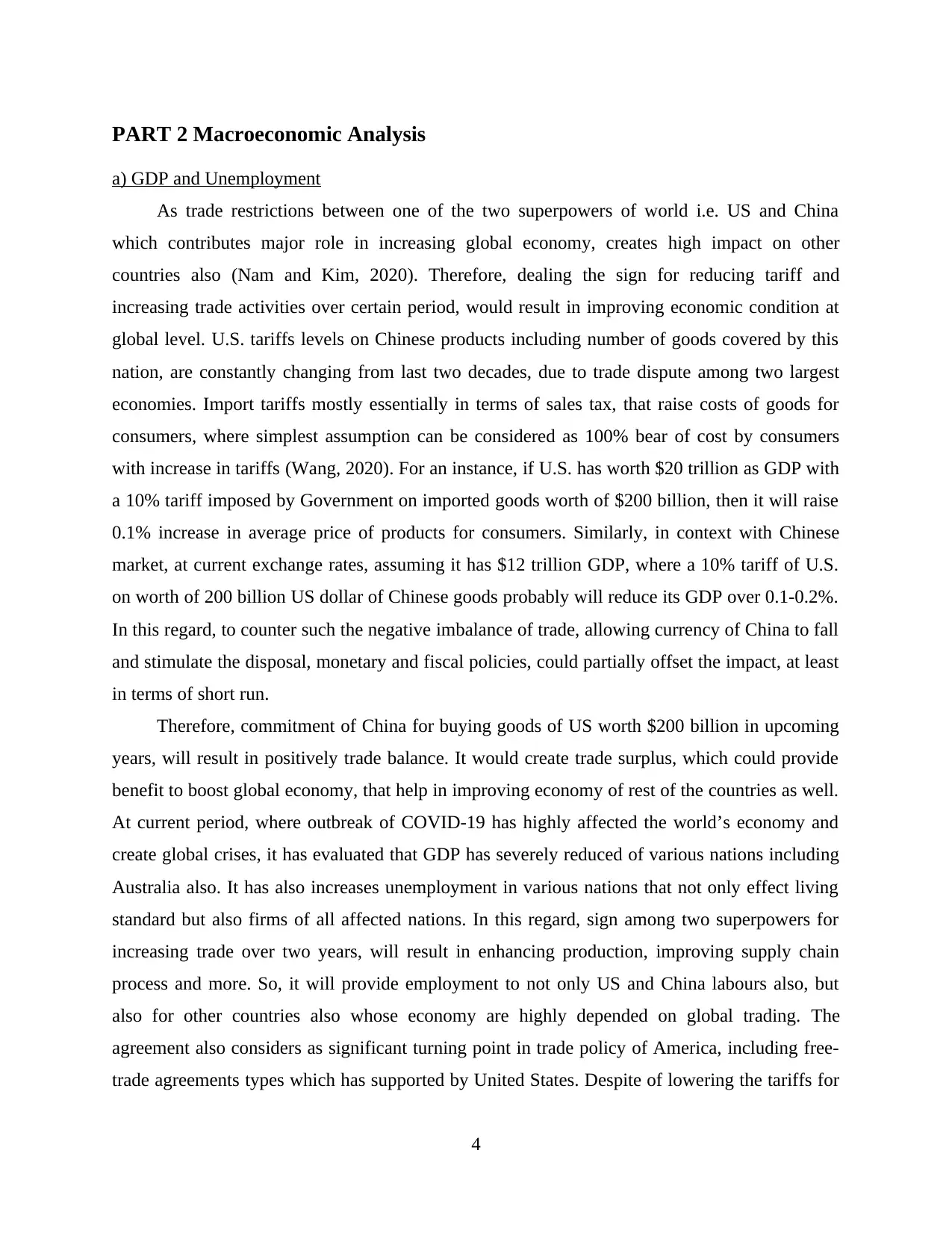
PART 2 Macroeconomic Analysis
a) GDP and Unemployment
As trade restrictions between one of the two superpowers of world i.e. US and China
which contributes major role in increasing global economy, creates high impact on other
countries also (Nam and Kim, 2020). Therefore, dealing the sign for reducing tariff and
increasing trade activities over certain period, would result in improving economic condition at
global level. U.S. tariffs levels on Chinese products including number of goods covered by this
nation, are constantly changing from last two decades, due to trade dispute among two largest
economies. Import tariffs mostly essentially in terms of sales tax, that raise costs of goods for
consumers, where simplest assumption can be considered as 100% bear of cost by consumers
with increase in tariffs (Wang, 2020). For an instance, if U.S. has worth $20 trillion as GDP with
a 10% tariff imposed by Government on imported goods worth of $200 billion, then it will raise
0.1% increase in average price of products for consumers. Similarly, in context with Chinese
market, at current exchange rates, assuming it has $12 trillion GDP, where a 10% tariff of U.S.
on worth of 200 billion US dollar of Chinese goods probably will reduce its GDP over 0.1-0.2%.
In this regard, to counter such the negative imbalance of trade, allowing currency of China to fall
and stimulate the disposal, monetary and fiscal policies, could partially offset the impact, at least
in terms of short run.
Therefore, commitment of China for buying goods of US worth $200 billion in upcoming
years, will result in positively trade balance. It would create trade surplus, which could provide
benefit to boost global economy, that help in improving economy of rest of the countries as well.
At current period, where outbreak of COVID-19 has highly affected the world’s economy and
create global crises, it has evaluated that GDP has severely reduced of various nations including
Australia also. It has also increases unemployment in various nations that not only effect living
standard but also firms of all affected nations. In this regard, sign among two superpowers for
increasing trade over two years, will result in enhancing production, improving supply chain
process and more. So, it will provide employment to not only US and China labours also, but
also for other countries also whose economy are highly depended on global trading. The
agreement also considers as significant turning point in trade policy of America, including free-
trade agreements types which has supported by United States. Despite of lowering the tariffs for
4
a) GDP and Unemployment
As trade restrictions between one of the two superpowers of world i.e. US and China
which contributes major role in increasing global economy, creates high impact on other
countries also (Nam and Kim, 2020). Therefore, dealing the sign for reducing tariff and
increasing trade activities over certain period, would result in improving economic condition at
global level. U.S. tariffs levels on Chinese products including number of goods covered by this
nation, are constantly changing from last two decades, due to trade dispute among two largest
economies. Import tariffs mostly essentially in terms of sales tax, that raise costs of goods for
consumers, where simplest assumption can be considered as 100% bear of cost by consumers
with increase in tariffs (Wang, 2020). For an instance, if U.S. has worth $20 trillion as GDP with
a 10% tariff imposed by Government on imported goods worth of $200 billion, then it will raise
0.1% increase in average price of products for consumers. Similarly, in context with Chinese
market, at current exchange rates, assuming it has $12 trillion GDP, where a 10% tariff of U.S.
on worth of 200 billion US dollar of Chinese goods probably will reduce its GDP over 0.1-0.2%.
In this regard, to counter such the negative imbalance of trade, allowing currency of China to fall
and stimulate the disposal, monetary and fiscal policies, could partially offset the impact, at least
in terms of short run.
Therefore, commitment of China for buying goods of US worth $200 billion in upcoming
years, will result in positively trade balance. It would create trade surplus, which could provide
benefit to boost global economy, that help in improving economy of rest of the countries as well.
At current period, where outbreak of COVID-19 has highly affected the world’s economy and
create global crises, it has evaluated that GDP has severely reduced of various nations including
Australia also. It has also increases unemployment in various nations that not only effect living
standard but also firms of all affected nations. In this regard, sign among two superpowers for
increasing trade over two years, will result in enhancing production, improving supply chain
process and more. So, it will provide employment to not only US and China labours also, but
also for other countries also whose economy are highly depended on global trading. The
agreement also considers as significant turning point in trade policy of America, including free-
trade agreements types which has supported by United States. Despite of lowering the tariffs for
4
Paraphrase This Document
Need a fresh take? Get an instant paraphrase of this document with our AI Paraphraser
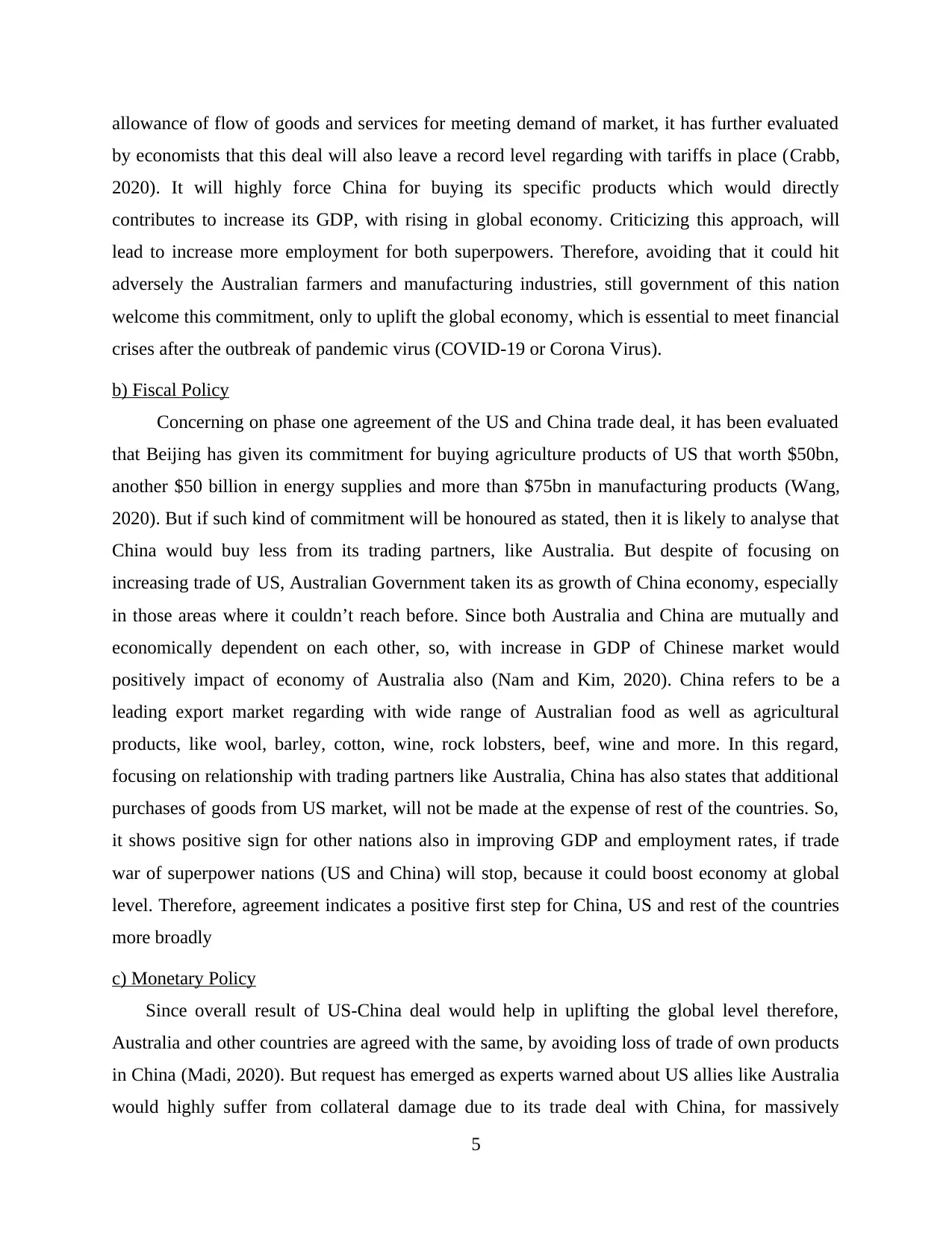
allowance of flow of goods and services for meeting demand of market, it has further evaluated
by economists that this deal will also leave a record level regarding with tariffs in place (Crabb,
2020). It will highly force China for buying its specific products which would directly
contributes to increase its GDP, with rising in global economy. Criticizing this approach, will
lead to increase more employment for both superpowers. Therefore, avoiding that it could hit
adversely the Australian farmers and manufacturing industries, still government of this nation
welcome this commitment, only to uplift the global economy, which is essential to meet financial
crises after the outbreak of pandemic virus (COVID-19 or Corona Virus).
b) Fiscal Policy
Concerning on phase one agreement of the US and China trade deal, it has been evaluated
that Beijing has given its commitment for buying agriculture products of US that worth $50bn,
another $50 billion in energy supplies and more than $75bn in manufacturing products (Wang,
2020). But if such kind of commitment will be honoured as stated, then it is likely to analyse that
China would buy less from its trading partners, like Australia. But despite of focusing on
increasing trade of US, Australian Government taken its as growth of China economy, especially
in those areas where it couldn’t reach before. Since both Australia and China are mutually and
economically dependent on each other, so, with increase in GDP of Chinese market would
positively impact of economy of Australia also (Nam and Kim, 2020). China refers to be a
leading export market regarding with wide range of Australian food as well as agricultural
products, like wool, barley, cotton, wine, rock lobsters, beef, wine and more. In this regard,
focusing on relationship with trading partners like Australia, China has also states that additional
purchases of goods from US market, will not be made at the expense of rest of the countries. So,
it shows positive sign for other nations also in improving GDP and employment rates, if trade
war of superpower nations (US and China) will stop, because it could boost economy at global
level. Therefore, agreement indicates a positive first step for China, US and rest of the countries
more broadly
c) Monetary Policy
Since overall result of US-China deal would help in uplifting the global level therefore,
Australia and other countries are agreed with the same, by avoiding loss of trade of own products
in China (Madi, 2020). But request has emerged as experts warned about US allies like Australia
would highly suffer from collateral damage due to its trade deal with China, for massively
5
by economists that this deal will also leave a record level regarding with tariffs in place (Crabb,
2020). It will highly force China for buying its specific products which would directly
contributes to increase its GDP, with rising in global economy. Criticizing this approach, will
lead to increase more employment for both superpowers. Therefore, avoiding that it could hit
adversely the Australian farmers and manufacturing industries, still government of this nation
welcome this commitment, only to uplift the global economy, which is essential to meet financial
crises after the outbreak of pandemic virus (COVID-19 or Corona Virus).
b) Fiscal Policy
Concerning on phase one agreement of the US and China trade deal, it has been evaluated
that Beijing has given its commitment for buying agriculture products of US that worth $50bn,
another $50 billion in energy supplies and more than $75bn in manufacturing products (Wang,
2020). But if such kind of commitment will be honoured as stated, then it is likely to analyse that
China would buy less from its trading partners, like Australia. But despite of focusing on
increasing trade of US, Australian Government taken its as growth of China economy, especially
in those areas where it couldn’t reach before. Since both Australia and China are mutually and
economically dependent on each other, so, with increase in GDP of Chinese market would
positively impact of economy of Australia also (Nam and Kim, 2020). China refers to be a
leading export market regarding with wide range of Australian food as well as agricultural
products, like wool, barley, cotton, wine, rock lobsters, beef, wine and more. In this regard,
focusing on relationship with trading partners like Australia, China has also states that additional
purchases of goods from US market, will not be made at the expense of rest of the countries. So,
it shows positive sign for other nations also in improving GDP and employment rates, if trade
war of superpower nations (US and China) will stop, because it could boost economy at global
level. Therefore, agreement indicates a positive first step for China, US and rest of the countries
more broadly
c) Monetary Policy
Since overall result of US-China deal would help in uplifting the global level therefore,
Australia and other countries are agreed with the same, by avoiding loss of trade of own products
in China (Madi, 2020). But request has emerged as experts warned about US allies like Australia
would highly suffer from collateral damage due to its trade deal with China, for massively
5
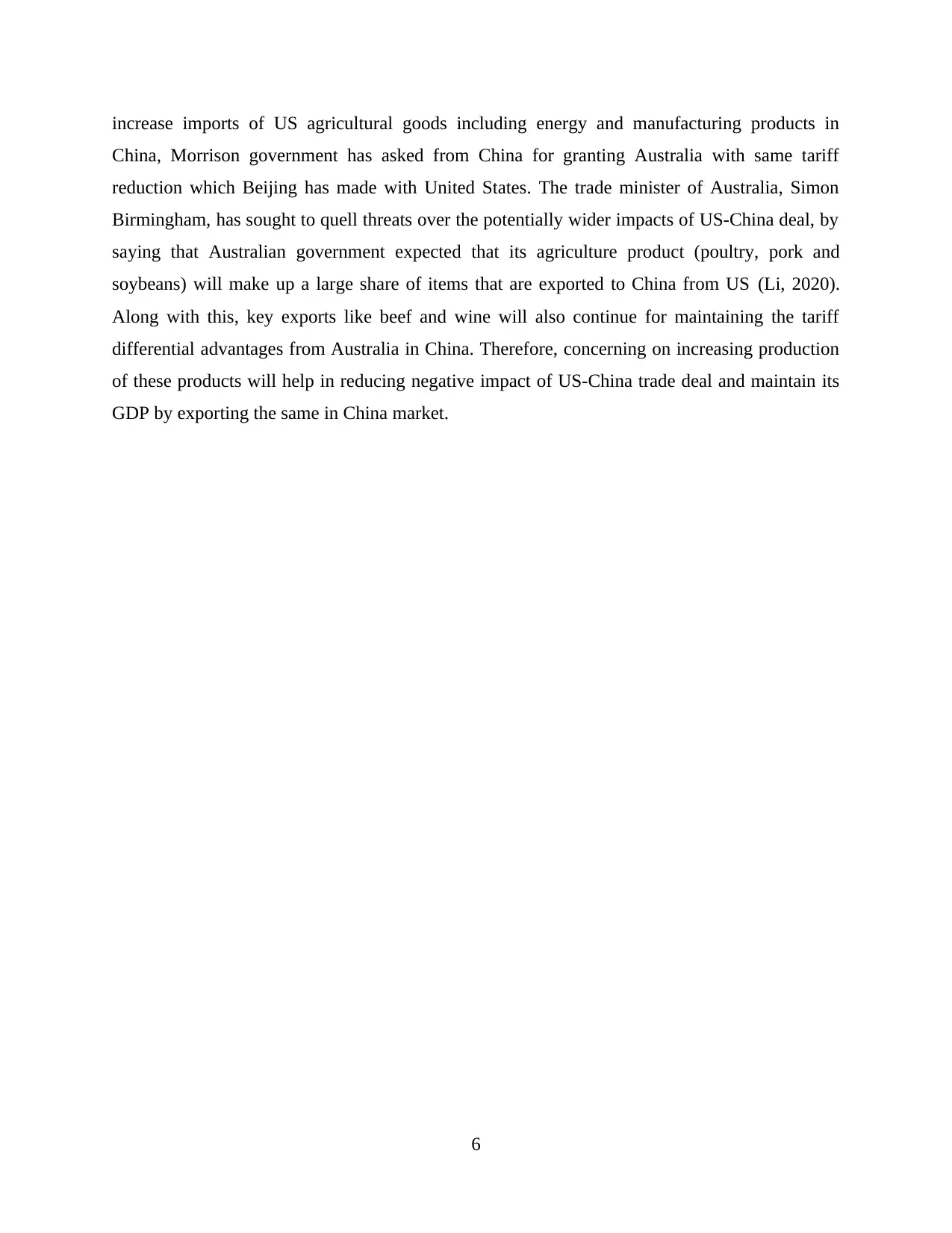
increase imports of US agricultural goods including energy and manufacturing products in
China, Morrison government has asked from China for granting Australia with same tariff
reduction which Beijing has made with United States. The trade minister of Australia, Simon
Birmingham, has sought to quell threats over the potentially wider impacts of US-China deal, by
saying that Australian government expected that its agriculture product (poultry, pork and
soybeans) will make up a large share of items that are exported to China from US (Li, 2020).
Along with this, key exports like beef and wine will also continue for maintaining the tariff
differential advantages from Australia in China. Therefore, concerning on increasing production
of these products will help in reducing negative impact of US-China trade deal and maintain its
GDP by exporting the same in China market.
6
China, Morrison government has asked from China for granting Australia with same tariff
reduction which Beijing has made with United States. The trade minister of Australia, Simon
Birmingham, has sought to quell threats over the potentially wider impacts of US-China deal, by
saying that Australian government expected that its agriculture product (poultry, pork and
soybeans) will make up a large share of items that are exported to China from US (Li, 2020).
Along with this, key exports like beef and wine will also continue for maintaining the tariff
differential advantages from Australia in China. Therefore, concerning on increasing production
of these products will help in reducing negative impact of US-China trade deal and maintain its
GDP by exporting the same in China market.
6
⊘ This is a preview!⊘
Do you want full access?
Subscribe today to unlock all pages.

Trusted by 1+ million students worldwide
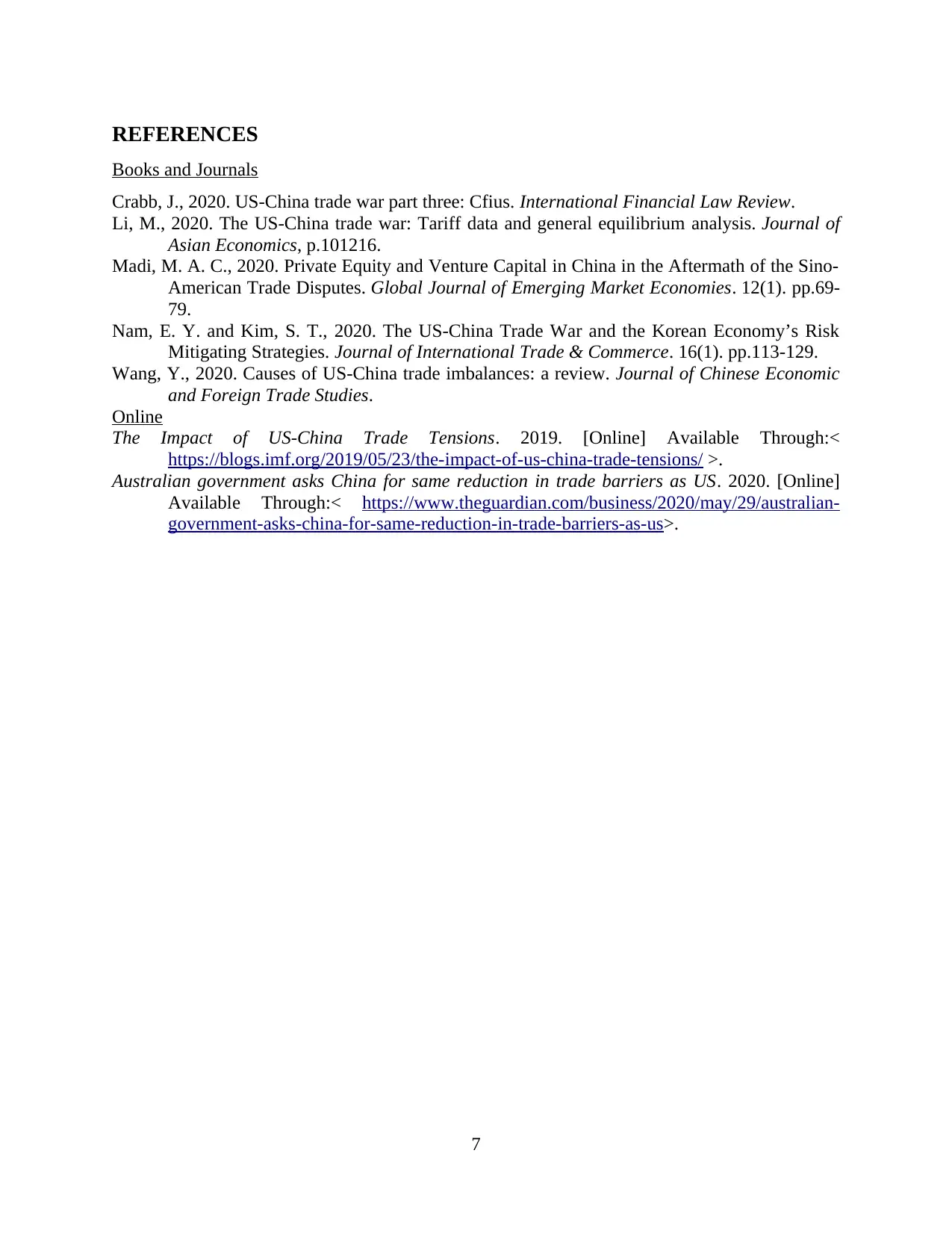
REFERENCES
Books and Journals
Crabb, J., 2020. US-China trade war part three: Cfius. International Financial Law Review.
Li, M., 2020. The US-China trade war: Tariff data and general equilibrium analysis. Journal of
Asian Economics, p.101216.
Madi, M. A. C., 2020. Private Equity and Venture Capital in China in the Aftermath of the Sino-
American Trade Disputes. Global Journal of Emerging Market Economies. 12(1). pp.69-
79.
Nam, E. Y. and Kim, S. T., 2020. The US-China Trade War and the Korean Economy’s Risk
Mitigating Strategies. Journal of International Trade & Commerce. 16(1). pp.113-129.
Wang, Y., 2020. Causes of US-China trade imbalances: a review. Journal of Chinese Economic
and Foreign Trade Studies.
Online
The Impact of US-China Trade Tensions. 2019. [Online] Available Through:<
https://blogs.imf.org/2019/05/23/the-impact-of-us-china-trade-tensions/ >.
Australian government asks China for same reduction in trade barriers as US. 2020. [Online]
Available Through:< https://www.theguardian.com/business/2020/may/29/australian-
government-asks-china-for-same-reduction-in-trade-barriers-as-us>.
7
Books and Journals
Crabb, J., 2020. US-China trade war part three: Cfius. International Financial Law Review.
Li, M., 2020. The US-China trade war: Tariff data and general equilibrium analysis. Journal of
Asian Economics, p.101216.
Madi, M. A. C., 2020. Private Equity and Venture Capital in China in the Aftermath of the Sino-
American Trade Disputes. Global Journal of Emerging Market Economies. 12(1). pp.69-
79.
Nam, E. Y. and Kim, S. T., 2020. The US-China Trade War and the Korean Economy’s Risk
Mitigating Strategies. Journal of International Trade & Commerce. 16(1). pp.113-129.
Wang, Y., 2020. Causes of US-China trade imbalances: a review. Journal of Chinese Economic
and Foreign Trade Studies.
Online
The Impact of US-China Trade Tensions. 2019. [Online] Available Through:<
https://blogs.imf.org/2019/05/23/the-impact-of-us-china-trade-tensions/ >.
Australian government asks China for same reduction in trade barriers as US. 2020. [Online]
Available Through:< https://www.theguardian.com/business/2020/may/29/australian-
government-asks-china-for-same-reduction-in-trade-barriers-as-us>.
7
1 out of 10
Related Documents
Your All-in-One AI-Powered Toolkit for Academic Success.
+13062052269
info@desklib.com
Available 24*7 on WhatsApp / Email
![[object Object]](/_next/static/media/star-bottom.7253800d.svg)
Unlock your academic potential
Copyright © 2020–2025 A2Z Services. All Rights Reserved. Developed and managed by ZUCOL.





